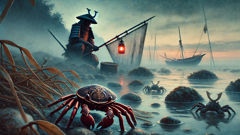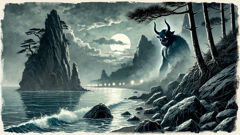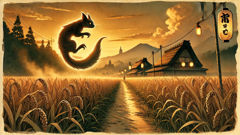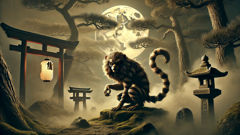Introduction
Beyond the harbor where fishermen mend nets and gulls glide like thin white blades across the sky, the sea keeps a memory as clear and stubborn as stone. It wears grief like a tide. On nights when the moon leans low and the salt wind carries the smell of kelp and tar, local people still speak in quiet voices of a battle that clove open this strait centuries ago; a fight so terrible that it altered the very patterns left by the waves. The Genpei War left scars on wood and bone and on the consciousness of coastal villages—woeful names, broken banners, and a thousand small deaths carried out to the quiet of the seabed. At Dan-no-ura, where currents meet and whirl like the teeth of a blade, the Heike—also called the Taira—met their ruin. Ships were overturned, helmets clattered and sank, and men who had once stood proud in lacquer and silk were claimed by cold, indifferent water. Over time, as fishermen hauled their pots and children collected shells, people noticed something odd: small crabs, no larger than a palm, whose carapaces bore ridges that seemed to form human faces. Some shells looked like helmets dented by blows, some like stern brows beneath a faded crest. The pattern was not natural to many eyes; it argued for an order that belonged to human sorrow. The villagers told one another stories—at the hearth, beneath the eaves after long days, in the hush of shrines—about how the fallen Heike could not rest. They said the samurai's faces returned in the curve of a crab shell, that what was lost at Dan-no-ura refused to dissolve into anonymous sediment. The crabs were not merely creatures; they were the waiting of remorse made small. More than a curiosity, the Heikegani became a living memorial, a way the sea itself kept faith with history. In this telling, the natural and the supernatural braided together; fishermen and priests, scholars and children, all passed down the same trembling hypothesis like a prayer: that the Heike, unwilling or unable to pass, found new flesh in tiny armored backs, and that by catching them and returning them, by speaking their names or leaving offerings by the shore, the living could help the lost find a path into final rest. Threads of doubt tied themselves to scientific curiosity, and the legend endured—part elegy, part warning, part explanation for a pattern no one could easily forget. This story follows the slow, patient life of the strait: the fishermen whose nets combed graves for glinting relics, the temple down the lane whose priests kept ashes and prayers, the children who found faces in shells, and the crabs themselves, anonymous and stubborn, carrying the impression of a human countenance like a relic. It is a tale that crosses time—bridging the medieval roar of steel with the hush of modern memory—and in its telling we will touch on history and myth, ritual and science, and the quiet human need to remember those who were swept away.
The Battle, the Sea, and the First Faces
The story of Dan-no-ura begins in the shape of a storm on the horizon of memory: a clash of banners and the roar of oars, the brittle crack of lacquered armor under sudden, terrifying blows. The Genpei War, a final convulsion of ambition between the Taira (Heike) and the Minamoto (Genji), sent fleets into the narrow places of the Inland Sea. Dan-no-ura is where currents twist bitterly and the water remembers every struggle it has ever hosted. Sailors and historians speak of strategy and tides: who held the wind, how armor shone in the sun, how commanders leaned into the roar. But at the human edge of that event were men whose faces were known to children and priests—brothers and fathers, masters and retainers—all of them brought down into the cold, many of them leaving behind more names than graves. For villagers along the coast, the immediate aftermath was practical grief. The sea yielded small spoils and strange remnants: lacquered fragments, golden fittings, belts and buckles, a helmet here or there jammed in the rocks. Yet out of these finds came a quieter, deeper wonder. In the nets and underfoot among seaweed, people began to notice small crabs whose shells bore ridges and swirls that resembled human faces—some angry, some resigned, some stunned in the look of a man who had just remembered he would die. They showed these shells to one another by lantern light, tracing the grooves and seeing not random pattern but intent, like the brush strokes of a potter who had once painted a face. Stories grew to meet the sighting. Old women muttered that the Heike's souls were too proud to be swallowed into nameless clay; priests told of restless hearts that sought sign; fishermen said they had caught a body and watched as the sea offered it another. The notion took on a logic that mixed grief with the world's need to explain. If a samurai's life had been marked by a crest and a face, why would the world erase that identity simply because of water? Better, perhaps, that the sea should wear those faces as a permanent echo. The earliest accounts of what we now call Heikegani were not written as proof but as testimony: a neighbor's nephew had pulled one up in the spring, unrolling his net to find, tucked among the kelp, a crab whose carapace looked for all the world like a helmet dented in fight. He kept it for a while, setting it on the household altar when storms came, a small, improvised kami who listened when the family had no other words. Over time, informal rituals formed—an offering of rice to a crab left under driftwood, a whispered name. The crabs became portable monuments. Some fishermen, superstitious and tender, refused to eat them. Others sold them, and the sight of jars or trays lined with these patterned shells multiplied the story into nearby towns and on to traveling storytellers. The living needed a place to set their shame and their sorrow; they found it in the patterned backs of small crustaceans, as if the sea had shaped a language of grief that everyone could read at once. When scholars later came, they measured and catalogued and argued about natural selection and shell morphology. But the human story remained: a coastline's way of keeping company with the dead, a cultural practice that held loss in the palm of one's hand and taught people how to touch history gently. Those first faces were not carved by hands but perceived by ones that ache to remember, and perception, in places like this, is as binding as any formal monument.
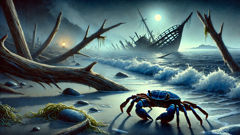
Fishermen, Priests, and the Rituals of Remembering
The legend that crabs carried the faces of fallen Heike warriors could have stayed a hushed tale had it not been for the people whose lives brushed the sea every day. Fishermen were its first sustainers: the men who went out before dawn, who knew the moods of tides intimately and who hauled their catch in hands salted by work. To them, a Heikegani was not only an oddity but a messenger. Old fishermen told of nights when the sea was black and everything seemed unanchored: buoys disappeared, net floats drifted past silently, and at dawn, along the low tide, a scattering of crabs could be found sheltered among stones, each carapace carrying the impression of a human face. Some of these men, when asked by officials to hand over their finds, would instead take the crabs to temples or small roadside shrines. There was a gentle logic to this. A priest could bury a plea with incense and sutra; a temple could perform rites that food and ale could not achieve. At the larger temples near the strait, monks wrote prayers for the souls of the Heike, chanting in rhythms old as the tides. People brought offerings: a bowl of rice, a strip of cloth, coins placed atop small stones. The rituals were modest but persisted across generations. The image of a crab set beside an incense stand is an image of improvisation: a community that lacks a grand monument uses what it has—sea creatures, stones, songs—to enact memory. Children learned the story as they learned the geography of rock pools, memorizing which tide pools sheltered which creatures and which names belonged to which pebble. Some families kept Heikegani as charms against misfortune, believing that a shell with a face watched over their hut and would turn away storms. Other families buried them with the rice harvest, a quiet offering so that the sea's burden might ease. But customs drift and change; with the passage of centuries, scientific eyes came. Naturalists observed that many crabs share patterns on their shells due to growth and the invasion of barnacles and other micro-conditions that produce lines and nodules. They could explain shapes and colors and the way weathered shells adopt familiar geometries. Yet the presence of explanation did not collapse faith. The coexistence of myth and science here felt less like contradiction and more like two languages describing the same ache. For villagers, lining up an explanation beside a prayer felt unnecessary: one addressed the head, the other the heart. In small shrines, the old rules remained: put down a pebble, utter the name, set aside the Heikegani so that it might be left in peace. Stories of miracles threaded through these acts. A woman once placed a crab beneath the eaves in memory of a son who never returned; months later, when the son’s old comrade came through the village, he recognized a knot of cloth from the son’s sash and, staring at the Heikegani, whispered the boy’s name before vanishing into fog. Whether coincidence or something else, such tales reinforced ritual. The priests expanded their rites with sutras and memorial services; fishermen learned to handle their finds with reverence. Around these practices coalesced a cultural ecology: a way that people and place, memory and living sea, made something resembling a covenant. The crabs would carry the faces; the living would carry the remembering. Over and over, in hushed pleasure or stern admonition, elders warned children not to scorn the sea’s offerings, because what is small may carry the weight of the world. In the marketplace and on the road, storytellers embroidered these encounters into long, patient narratives that taught empathy as much as history. If a child marveled at a Heikegani, an elder would answer with a phrase that might at first seem odd: “You look upon a memory. Treat it as you would a grave.” That line, simple and sharp, kept a community tethered to its past and ensured that the ritual of remembering did not die when the details did.
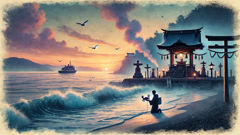
Science, Story, and the Living Memory of the Sea
As ports grew and universities formed their natural history collections, the Heikegani traveled beyond local shrines into cabinets of study. Scholars catalogued specimens, compared shells, and debated taxonomy. They pointed to ecological mechanisms—genetics, developmental processes, mimicry—and demonstrated how selection pressures and environmental factors produce recurring shell patterns. For many people outside the immediate coastal world, this scientific framing felt like sufficient resolution: a natural explanation for what others had called a miracle. Yet the story did not vanish under microscope or ledger. In towns and small cities, in temples and classrooms, the Heikegani remained a living hinge between human memory and the mind of nature. Teachers used the tale to discuss how history lived not merely in books but in landscapes and living things: every coastline contains stories, and some of those stories are encoded in the organisms that call those coasts home. In modern times, the strait has become a place of layered meanings. Ferry engines hum where arrowheads once flew. Tourists stop to photograph the water and to buy souvenirs stamped with tiny crab faces. Environmentalists point to the Heikegani as emblematic of the sea’s fragility and insist that protecting habitats also preserves cultural narratives. Anthropologists study the rituals of offering and find, in them, evidence of a universal human strategy: create tangible practices to keep the dead near enough to be honored. Meanwhile, elders continue to tell the same basic story to any child who will listen, and children listen with a pleasure that is not only for the macabre. They learn about the audacity of devotion and the intimacy of memory. A popular detail in these retellings is the idea that the crabs themselves will not allow a warrior to remain unremembered. If a fisherman is cruel or absent-minded, the Heikegani's shell may seem to glare at him as though accusing him of forgetting. Conversely, careful handling is said to produce calmer crabs; a person who treats the sea's offerings with kindness will find fewer storms and a safer crossing. There is a moral economy at play: respect begets ease. Sometimes, scientific opinion and local lore enter public debate about conservation and heritage. When coastal development threatens rock pools and intertidal zones, campaigns to protect those habitats invoke both biology and story. Arguments framed in science move policy; arguments framed in culture move hearts. Local councils, monasteries, and civic groups collaborate to plant kelp beds and regulate harvests, and the Heikegani becomes a symbol of what is worth saving—not only for biodiversity but for a nation’s capacity to remember. Whether one reads the crabs as biological oddities or as incarnated souls, they function as a living archive. They teach that memory can inhabit strange forms and that honoring the past can look like small things: a bowl of rice, a whispered name, a protected tidal pool. In that sense the legend performs a civic ritual; by enacting it, communities rehearse the values they want to pass on. The sea, always indifferent, nevertheless participates in this rehearsal. Tides do their old work of conceal and reveal. Storms bring new formations along the shore. Children continue to find faces in shells, and elders continue to nod and say the names. Modernity has not erased the urge to remember; it has multiplied the ways memory can be performed. The Heikegani thus remains both a scholarly curiosity and a cultural anchor, demonstrating how humans transform the presence of nature into meaning. In the shells of these small crabs, the past is neither inert nor entirely explained away. It is something to be tended, like a garden or a grave, requiring care and speech and sometimes, stubbornly, belief.
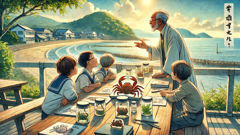
Conclusion
The Heikegani tale endures because it answers a deep human need: to hold the names of those who were swept away and to fashion a place—however humble—where grief can be practiced. The legend asks us to consider how we remember, and what we will accept as memorial. Will a nation only honor its dead with stone monuments and incense halls, or will it also notice the small signs on the margins—faces in shells, patterns in tide pools—that insist memory is not only grand but intimate? In villages around the Inland Sea, the answer has long been neither exclusively one nor the other. People bend low, set down offerings, and trace the ridges on a carapace as if reading a familiar face. These acts are not mere superstition; they are choices about how to live with loss and how to teach subsequent generations that history is not only told but tended. The Heikegani carries more than a legend: it carries a model for how communities may hold onto the past without being crushed by it. The crabs, for their part, continue their small, indifferent lives, scuttling among rocks and kelp, unaffected by the seriousness we bestow on them. Yet even the indifference of nature can serve as vessel for human meaning. If the shells indeed bear the impressions of fallen warriors, then each tide that hides and reveals them becomes a living liturgy, and the sea itself a church of motion. If the patterns are biological accident, then our willingness to see faces there reveals our hunger for connection, our refusal to let names vanish without song. Either way, the story leaves a residue worth keeping: a call to remember the fallen with tenderness, and to let ordinary objects carry extraordinaries into our hands. Along the strait, where currents still quarrel and gulls wheel, the Heikegani teach a patient lesson: that memory, like the tide, returns when it is summoned, and that the smallest creature can hold a past vast enough to shape how a people imagine themselves.

